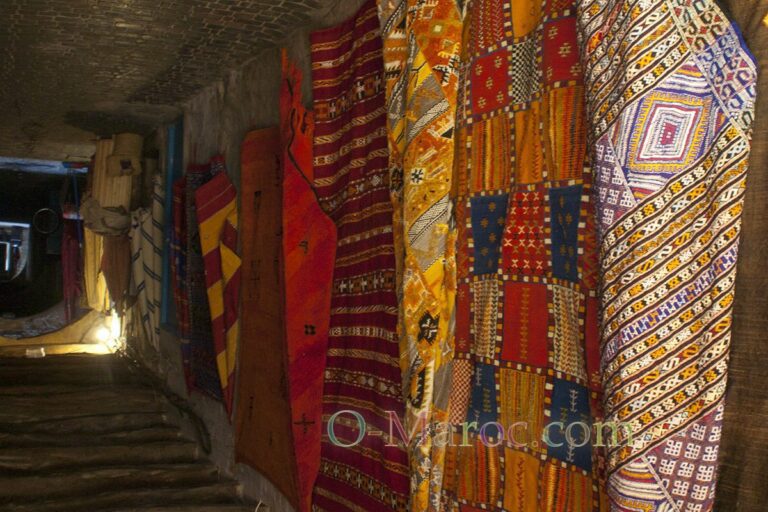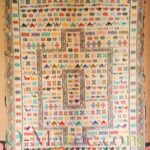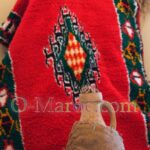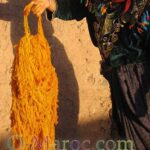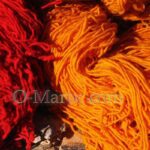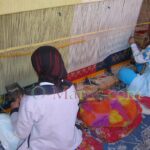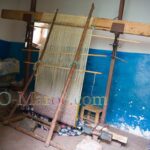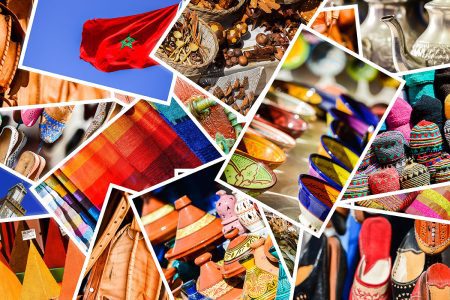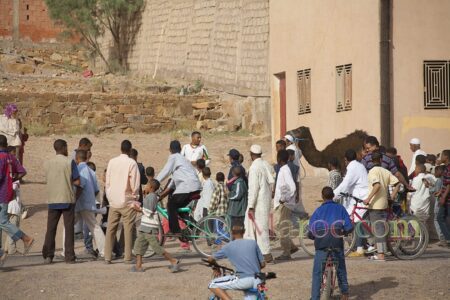Les tapis (dits kilims) sont au coeur de la vie berbère.
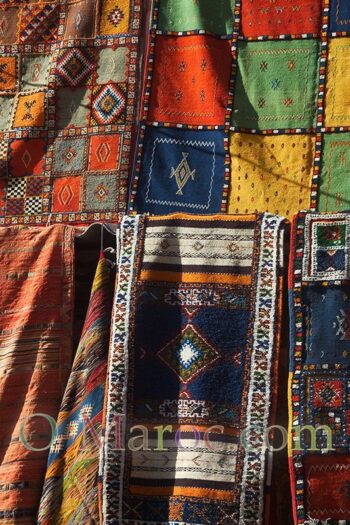
The term “kilim” is inappropriate.
In Morocco, the woven woollen rugs used as coats, blankets and floor mats are known as henbel or handira. But the word ‘kilim’ is universally known and easier to remember.
For a nomad, after a tent woven from camel wool, rugs are the first, if not the only, piece of furniture.
From the khaimas (Berber tents) of the Atlas to the rich Glaouis palaces or Fassis, the rugs are numerous, soft, colourful and richly decorated. They cover the floor, where they can be piled up in several layers, in winter they hang on the walls to protect the tiles from the cold, they cover sofas and beds, and the smaller ones can also be used as clothes, like the Hamdira of the Aït Haddidou.
In the past, every family had a loom where young girls prepared their wedding trousseau. Today, some of this work is carried out by cooperatives and workshops, notably in Taznekhat, but in the countryside, or in the tents of nomads, many women still weave rugs for themselves and their families, or for a not inconsiderable income. Outside Tazenakht, other cooperatives, such as Agouim, also produce quality rugs.
Unfortunately, the term ‘rug merchant‘ or ‘carpet dealer‘, with all its not-so-positive connotations, can be applied to most bazaarists, who will invite you with a ‘pleasure of the eyes’ to Recette - Thé à la menthe to unfurl all their rugs in front of you, offering you the best deal possible.
This moment can become a real pleasure if you know a bit about rugs, enough to make it clear that you won’t buy just anything any old how, and also to make the bazaarist want to share his knowledge… because he knows a lot about rugs, and by training him to talk about them, you may spend some long, fascinating hours, while he shows you his real treasures.
Photos de tapis marocains
(click on the thumbnails to enlarge).
Les différentes sortes de tapis
“City” rugs are mainly made in the region of Rabat, and this is how they are called. Their geometric and floral motifs are strongly inspired by Turkish rugs, which served as their initial inspiration. Village and nomad rugs are very varied, and although more rustic, can also be of excellent quality.
They can be differentiated according to the way they are made (woven, knotted, embroidered), their borders (one or two sides with fringes, or four sides), their material (wool or vegetable fibres), and of course according to their origin and the traditional motifs and colours of each tribe. Rugs can therefore be :
- woven and knotted
- woven and embroidered, i.e. henbel, hanbel or mergoum (in Berber), which merchants will usually refer to as kilims
- woven, knotted and embroidered in relief, the most precious.
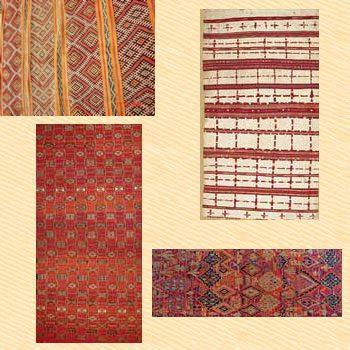
The rugs of Chichaoua, for example, are woven and knotted, often in solid colours (red or ochre), but worked so that they can be used on both sides, with one side for winter and one for summer.
Handiras from the Haut-Atlas have very long knots, and are used as rugs, blankets and even coats.
This is the traditional dress of brides from the Imilchil region.
Glawa rugs (named after the Glawi tribe, who ruled southern Morocco for half a century, from Marrakesh to the farthest reaches of the Draa Valley) are woven, knotted and embroidered, giving a beautiful relief effect. They are also recognisable by their four fringed sides, an exception in Morocco.
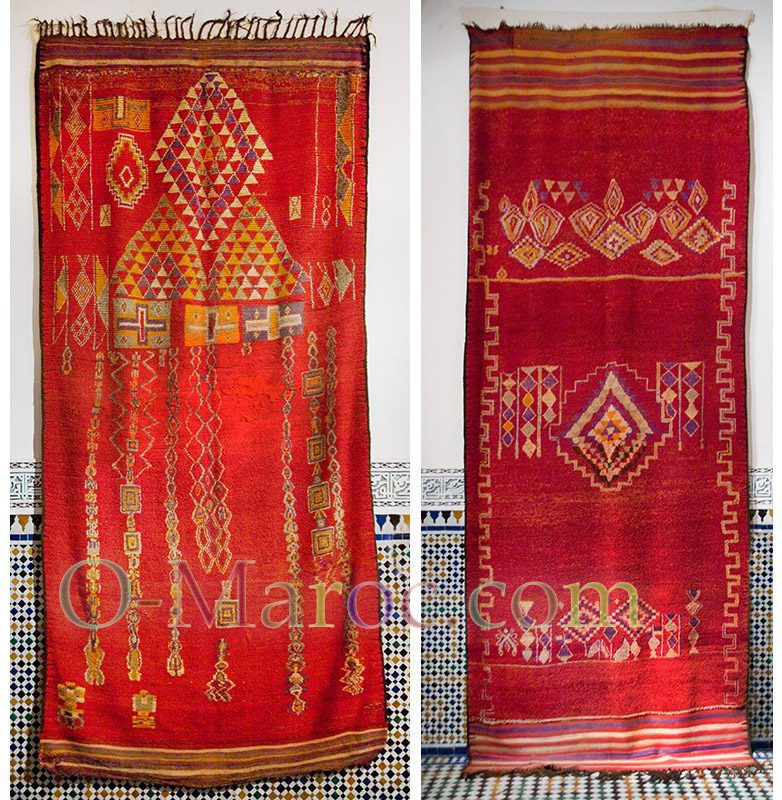
They are in intense, warm shades of black, orange and yellow, while the rugs of Ouarzazate are more in the reds, blues and whites, like those of Tazenakht, known for their bright colours, which have gradually spread throughout Morocco. As you head north, towards the Middle-Atlas, the bottom becomes beige.
How a Moroccan rug is made
Only women make the rugs, and only men sell them, with very rare exceptions such as the cooperative in Agouim, where the women sell their produce themselves. The wool is sheep’s, never camel’s or goat’s. For light summer rugs or the mats (agoutil) used in tents under the rugs, plant fibres such as cactus or esparto grass can also be used. Finally, if someone tries to sell you a rug with silk, you can be sure that it was not made in Morocco, as silk was never used.
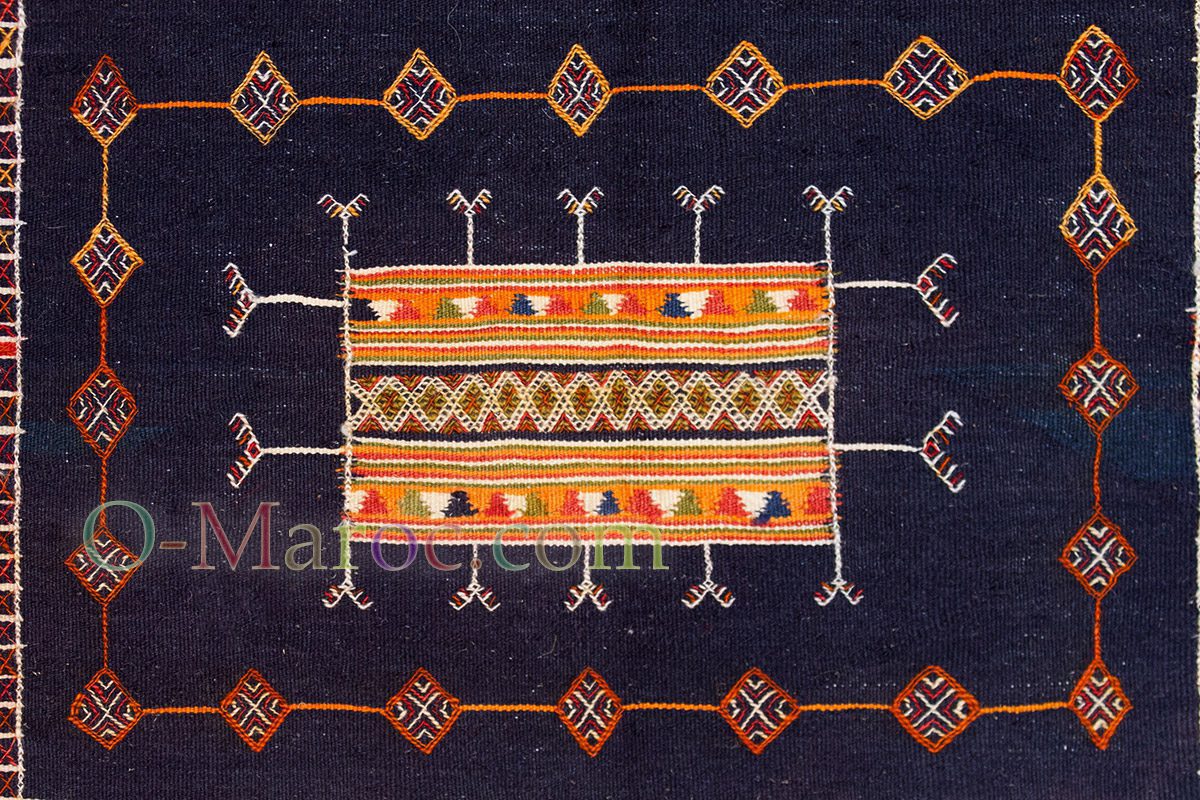
The motifs represent a large gathering, with the tents surrounding the palm grove. The small triangles inside the central rectangle represent the ‘usual’ tents on either side of the cultivated plots.
The traditional colours were made from plants, bark, cow urine or iron sulphate. These are now often replaced by wools dyed directly by the producer, using synthetic colours. In the long term, these won’t hold up as well, but in the short term, natural colours can sometimes bleed and stain the sofa you’ve laid your Hanbel on. Whether natural or synthetic, the colours of new rugs will change and fade slightly. But natural colours stabilise in a few years, while synthetic colours continue to fade.
- Saffron, in addition to its beautiful yellow colour, provided protection against moths. Very expensive, it can be replaced by pomegranate skins cooked in earthenware pots,
- red dyes are made from poppy, madder, henna or cochineal,
- yellows with saffron or henna,
- greens with alfalfa or cumin leaves,
- blue, of course, with indigo.
The nomadic loom is a vertical loom. It produces single-sided fringed rugs. It is also widely used in the villages.
The cooperatives in the villages generally have a few looms, which are moved from house to house, in turn. All the women gather around the loom and weave together, as a family, before it is moved once the rug is finished.
The rug is woven with a cedar shuttle, then embroidered with a very fine silver needle. The colours of new rugs will change (less if they are natural colours than if they are synthetic colours, which are increasingly common), and will only stabilise after several years. It is normal for your kilim to fade a littl.
Traditional Berber rug designs
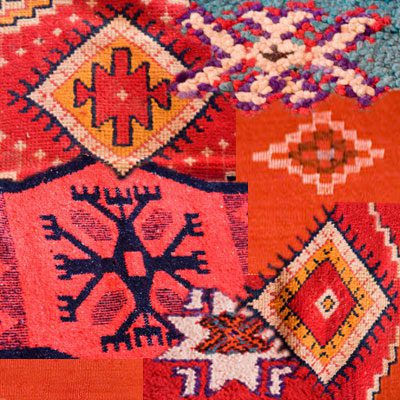
- the zigzag, a way of travelling, also represents water for more contact
- inverted triangles (like a ><) represent many opposing tents, the festival, the moussem, the meeting
- the beetle is the symbol of protection against the evil eye
- the pyramid shows the social pyramid, as well as the house, the douar, or the large tent with the three generations under the same roof, parents, sons and daughters-in-law and grandchildren
- the lozenges represent the 4 cardinal points, the square in the middle of the lozenges represents the 4 elements, the 4 seasons
- the fibula, an Amazigh symbol, is a weapon; its pointed side pierces the eye of someone who wants to cast a spell on you, it pierces the evil eye, and it points towards your enemy
- the dromedaries symbolise the dowry, and also the means to seek a new life; they are typical of wedding rugs
- the knots represent the kasbahs, while the weaving represents the fields, rivers and mountains.
Buy a Berber kilim
You buy a rug from a rug merchant… and that’s the problem! The production of the large cooperatives is controlled by a state body that sets official prices per square metre. These rugs are identified by labels:
- orange for extra quality (>360,000 dots per square metre)
- blue for superior quality
- green for standard quality
- yellow for average quality.
Without these labels (or to check them) here are a few guidelines for estimating quality:
- The lines of the designs, like the edges of the rug, must be straight, clean and not wavy (loose weave).
- You can check that the knots are tight by scraping them with your fingernail.
- Tear off a piece of wool from the back of the rug and burn it – it shouldn’t melt, but it shouldn’t burn and should smell like roasted mutton.
- Finally, there must be no silk, which has never been used in Moroccan rugs.
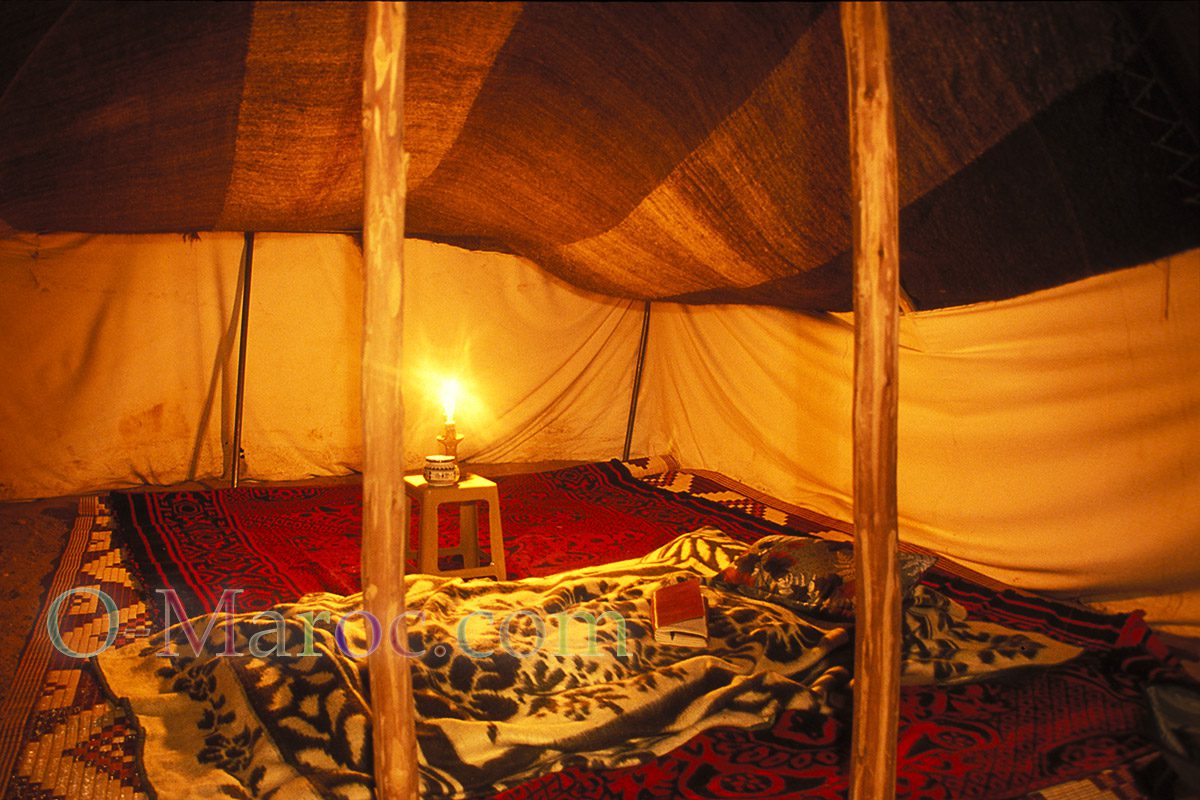
Paying the right price for a Moroccan rug.
In Morocco, all prices are negotiated, even between Moroccans. Apart from ‘fixed price’ shops and prices controlled by the state (such as the price of bread), there is not one price, but a multitude of possible prices for the same post, which will depend on the season, the merchant’s good humour, his need for money, your smile and your ability to negotiate, and many other imponderables – this is the land of ‘Inch Allah’ after all.
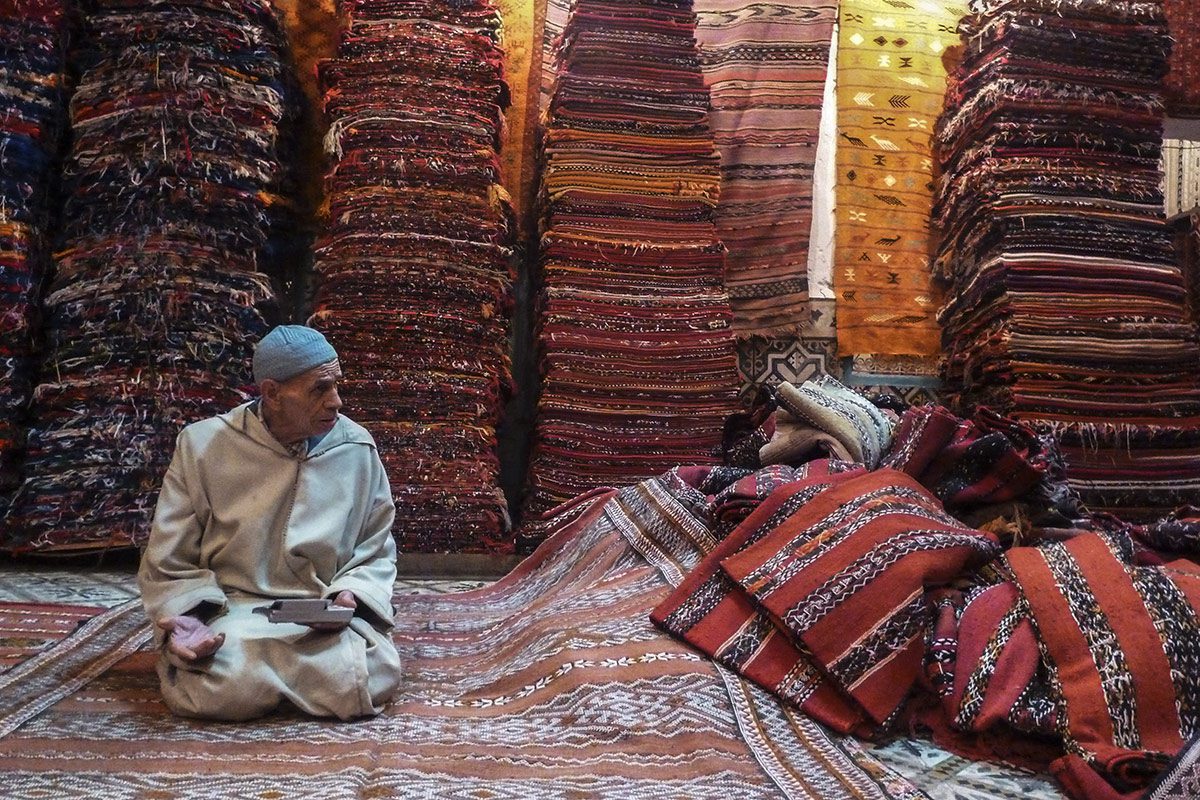
In this context, the right price is the one that will make you happy, and that will allow you to take away with pleasure a post that you really want. Don’t buy anything you’re not sure about. Bazaarists are very good at winning the decision, simply by stalling, by pity (how many of them have a whole family to feed, just waiting for you to finally eat something other than dry bread…), or even almost by force.
I’ve seen some guides, in collusion with merchants, practically snatch their customers’ credit cards and put moral pressure on them to sign. But nothing really obliges you to sign the invoice, and it’s always safer to pretend you’ve only got cash on you…
A good deal will be 3 to 4 times cheaper than in Europe. Whether you have your goods shipped or take them yourself, you’ll have to add transport costs (between €6 and €12 per kilo of excess baggage on airlines), and any customs duties and VAT on arrival in Europe, especially if the rug is bulky (there are no customs duties for the EEC since 1 January 2009, as Morocco has preferential agreements). Don’t forget to claim the invoice, which should mention Moroccan VAT so that you can deduct it from the price when clearing customs.
The wider and more complicated the border, the richer the pattern, the more expensive the rug. The thickness of the wool is also a criterion of quality and price, because soft woollen rugs cannot withstand frequent comings and goings, let alone our shoes and heels.
They can, however, make very beautiful bedspreads or sofa throws. They generally cost 800 to 1,200 dirhams per square metre, rising to 600 to 1,000 if you’re a good negotiator and in the low season. Kilims start at 300 dirhams per square metre, glaouias at least 700 dirhams.
Berber motifs: rugs and tattoos
There is, of course, something in common between the designs on rugs and those on Berber women’s tattoos.
But there are also differences. The tattoos are purely abstract; no woman has ever been seen with a camel tattoo.
Women’s tattoos are also more person-centred. They are protective tattoos, or tell a personal story (marriage, children, etc.), so we won’t see the motifs that symbolise the big tent gatherings.
The Beni-Warain craze
Since I wrote this post, Beni-Warain rugs (which were virtually unknown at the time) have become the darling of decorators. Simple, they fit into any decor.
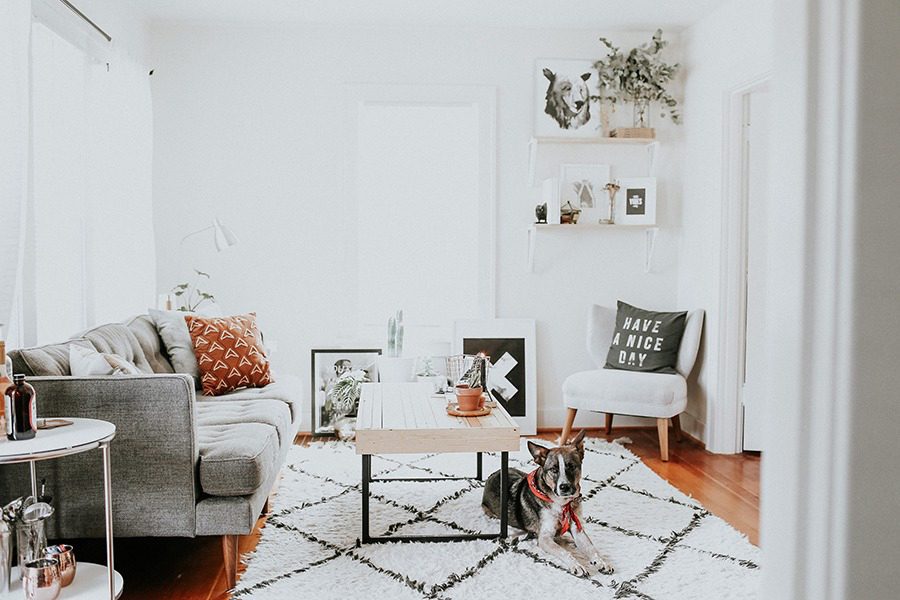
These are expensive rugs because they are made from white wool with light black geometric patterns. White wool is more expensive than any other wool. Moroccan sheep’s wool is often ochre or brown, or mixed, and its original colour disappears when dyed. To make a genuine Beni-Ouarain, you need a large quantity of high-quality wool.
So beware of Beni-Warain that is too cheap. It will often be “Beni Warain style” or, less honestly, a copy. There are even tutorials on the web on how to make a Beni-Warain with an Ikea rug and black paint!
 A typo or syntax error? You can select the text and hit Ctrl+Enter to send us a message. Thank you! If this post interested you, maybe you can also leave a comment. We'd love to exchange with you !
A typo or syntax error? You can select the text and hit Ctrl+Enter to send us a message. Thank you! If this post interested you, maybe you can also leave a comment. We'd love to exchange with you !

